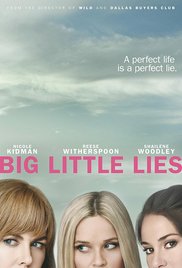
Robert McKee’s WORKS / DOESN’T WORK Film Review:
Big Little Lies (2017 – ) | Created by David E. Kelley
McKee Says: It Works (Spoiler Alert!)
EDITING TEMPO
BIG LITTLE LIES crosscuts three stories over seven-episodes, then pulls them together at Climax. But instead of limiting itself to the points of view of its three protagonists, the screenplay moves from place to place, person to person, telling the story from an omniscient, God-angle view—as did the third-person novel it adapted.
Free to take the telling where they like, the editing team cuts from the struggles of the protagonists, to the schemings of various antagonists, to snide comments from sideline characters, to inserts of California clichés. In fact, the editors toss in more images of crashing waves than you’d see in a surfing contest.
This brisk editing tempo serves two purposes:
(1) It counterpoints the subtexts of emotional paralysis and anxiety that haunt the three principals. Without these cutaways, the mini-series could have become as static and mood-ridden as a minimalist art film.
(2) These inter-scene montages also serve as a delaying tactic to heighten tension. The splicings busy our eyes while the crosscutting keeps the storytelling in the air, both devices forestalling answers to the ultimate questions: “Who going to die in this story? Who will do the killing?” As the ancient writer’s adage goes: “Make’em laugh, make’em cry, make’em wait.”
DRAMATIC IRONY TO HOOK SUSPENSE
Beginning in 2007, the closed-season series DAMAGES pioneered a radical technique: Each episode’s teaser flashed forward to a glimpse of that season’s violent climax. As the weeks went by, teaser after teaser gave us snippets of the future, but never enough to know what happened in full. We had to wait to the final episode to experience the grand climax.
Along the way, however, we watched the series through the lens of dramatic irony. Because of the teasers, we knew more than the characters knew; we knew they were heading for disaster. The effect of putting the audience ahead of the characters was twofold: One, it created suspense of a unique quality. Two, the audience’s curiosity looked deeper into the inner workings of the characters, asking, “How and why did these characters do what I already know they did?”
BIG LITTLE LIES uses the same essential technique but with a comic touch. Between turning points, the telling flash-forwards to a Don Rickles chorus of fast-talking insult artists who ridicule protagonists and antagonists alike. They play no direct roles in the core dramas but instead get laughs as they mock this cast of pretentious elites. Like the foretastes of the future in DAMAGES, these gossipers put the audience ahead of the main characters but keep the outcome to themselves.
SETTING AS SIMILE
The setting is the costume a story wears. Ideally, the writer would like to wrap her telling in a time and place that heightens the meaning and emotion of its events. The setting’s imagery then acts as a subliminal metaphor for the story’s positive versus negative charges, for good versus evil, comedy and tragedy. With that ambition, the final location of BIG LITTLE LIES is perfection.
The climax takes place at a fund-raising costume party with an Elvis Presley/Audrey Hepburn theme. Elvis’s leather jackets versus Hepburn’s pearl necklaces express the series’ polar conflict of male v. female, aggressor v. victim, but in a way that is at once romantic and dangerous, serious and humorous, over the top and below the belt.
I was hooked, held, and paid off. I’ll miss these fascinating characters and the superb actors who played them.